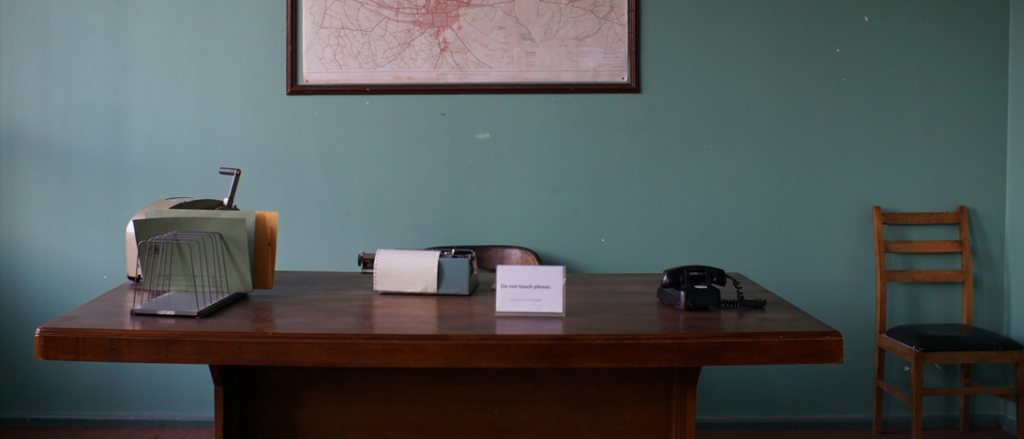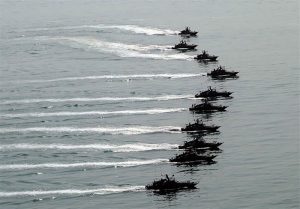The complicated history of US-Iran relations
5 min read
Preserved office with the original furniture and decoration at the former US Embassy in Tehran (Photo: Isabel Baldovi via shutterstock.com)
RESPONSIBLE STATECRAFT John Limbert 29 March 2021
Scholars have urged us, when looking at U.S.-Iran relations, to “take the long view.” It is a mistake, they tell us, to imagine that relations began in 1979 with the 14- month occupation of the American Embassy in Tehran. Or that they began in 1953 with the CIA-sponsored coup d’état against the nationalist government of Premier Mohammad Mosaddegh.
In such an approach, each country finds the other’s original sin that justifies self-righteousness and grievance, which have served neither side well. The result has been decades of reciprocal demonization and futility. Americans see Iranians as fanatics in thrall to aging theocrats. Iranians see Americans seeking to impose their will on smaller and weaker nations. Through this fog of complaints, the two sides communicate only through exchanges of insults, threats, accusations, and empty slogans. No one asks the question, “What do we hope to accomplish with this shouting? What have we accomplished?”
Serious studies of U.S.-Iran relations, such as James Bill’s excellent “The Eagle and the Lion” (Yale University Press 1988), take a longer and deeper view. Most begin in the middle to late nineteenth century with the arrival of American Protestant missionaries in what outsiders then called “Persia.” These missionaries converted some of Iran’s Assyrian Christians to Presbyterianism and established schools and hospitals in a country where, in 1905, life expectancy was 30 years, and the literacy rate was five percent.
These works also tell a story of Americans being mostly on the right side of Iranians’ long and difficult struggle to achieve dignity and independence from foreign control. They tell the story of “American martyr” Howard Baskerville, the young Princeton graduate killed fighting alongside Iran’s constitutionalists in 1909. They tell the story of Morgan Shuster, who helped the nascent Iranian parliament in its struggle to control Iranian finances and whom the Russians and British forced out in 1911 when he became too effective in his work. In more recent times, they tell the story of American diplomatic support for Iran’s efforts to regain control of its vital and threatened northwestern provinces after World War II.
In his new book, “America and Iran: A History 1720 to the Present,” scholar John Ghazvinian takes an even longer view. He writes that, as early as 1720, American colonial newspapers were covering events in distant Persia during the violent collapse of the Safavid Empire. At the time, the colonists, like other European Christians, saw the Sunni Ottoman Turks — who had besieged Vienna only forty years earlier — as the main threat to Christendom, and viewed the Shia Persian Empire as a possible ally.
There is much to discover and enjoy in this book. We learn, for example, the earliest American exports to Iran were aimed at consumers in two vital sectors of Iranian life: alcohol and religion. In 1830 the major American export to Persia was not New England Protestantism, but 12 million gallons of “Boston Particular” — rum laced with whiskey. Of course, missionaries, as they always do, followed the rum. In the 1830s and 40s, American Presbyterian missionaries appeared around Urumiya in northwestern Iran on a mission to convert the heretical Nestorian Christians there.
Bilateral diplomatic ties would come later in the nineteenth century but never provided the Iranians much help in their attempts to free themselves from Russian and British domination. Those powers were too strong, and Yengeh Donya (the New World) was too far away. One early high (or low) point came at the 1893 Chicago World’s Fair. The Persian government put on a serious cultural display of tiles, miniatures, and carpets, but somehow a performance of belly dancers overshadowed these efforts. Long lines of men waited for a chance to watch “Belle Baya” and her friends perform the “hoochie koochie,” while one observer wrote, “It is the coarse, animal passion of the East, not the chaste sentiment of Christian lands.”
It is obvious that since 1953 the relationship has been about much more than rum, missionaries, and belly dancers. The author devotes over two thirds of the book to those years: he writes about the oil nationalization crisis and the years that followed, including the 1953 coup, the White Revolution, the oil bonanza, the Islamic Revolution, the hostage crisis, Iran-contra, and the nuclear negotiations. The book ends in 2019 with Washington’s assassination of Revolutionary Guard General Qassem Soleimani and the tragic shooting-down of the Ukrainian airliner that followed.
Ghazvinian finds a consistent theme running through American dealings with Iran: an obliviousness that relied on easy assumptions and facile phrases (e.g “carrots and sticks,” “malign behavior,” and “new Persian empire”) and ignored inconvenient and complex realities. He notes the failure to see the Shah’s illness in the 1970s — a failure that would have disastrous consequences:
[American] spies failed to pick up on even the most basic intelligence, such as the fact that by the mid-1970s the shah was suffering from cancer. Even as rumors of the shah’s illness spread through Tehran…American officials reported to Washington the official Iranian line that the shah was in excellent health. Washington, in turn took these reports at face value and described Iran as a Middle Eastern success story – a rapidly modernizing pro-Western country with only a few minor difficulties. It was, according to a line frequently repeated by U.S. officials, an “island of stability and prosperity.”
Part of the tragedy of this history is that there are so many examples of what appears to be willful blindness. There was the foolish insistence on modifying the exiting status-of-forces agreement in 1963, the step that elevated Ayatollah Khomeini to an Iranian national hero; there was the appointment of the former head of the CIA as American ambassador in 1973, just to remind Iranians of who was really in charge of their country.
The author notes how, in 1979, Americans completely failed to recognize how the phantoms of 1953 were haunting subsequent generations of Iranians. He writes of conditions in 1979:
When it came to relations with America, however, one overriding anxiety did keep Iranians awake at night: the memory of 1953. As Iran’s new leaders struggled to ensure the survival of their revolution to assert control domestically, they were haunted – even obsessed – by fear that American spies might be cooking up some daring plot to whisk the shah back into power, as they had done twenty-five years earlier.
…More than anything else, this was the demon that haunted the Iranian psyche in 1979. And more than anything else, this was the demon that America’s leaders could not afford to ignore.
But ignore it they did.
So there you have it. All the elements of a great story: good intentions, self-sacrifice, nobility, greed, arrogance, and ignorance, with ghosts and demons thrown in.
Both the scholar and the student will enjoy this most readable and well-researched book. It is worth just opening a chapter at random. As the saying goes, “You can’t make this stuff up.”



